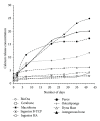Physicochemical characteristics of bone substitutes used in oral surgery in comparison to autogenous bone
- PMID: 25143936
- PMCID: PMC4119630
- DOI: 10.1155/2014/320790
Physicochemical characteristics of bone substitutes used in oral surgery in comparison to autogenous bone
Abstract
Bone substitutes used in oral surgery include allografts, xenografts, and synthetic materials that are frequently used to compensate bone loss or to reinforce repaired bone, but little is currently known about their physicochemical characteristics. The aim of this study was to evaluate a number of physical and chemical properties in a variety of granulated mineral-based biomaterials used in dentistry and to compare them with those of autogenous bone. Autogenous bone and eight commercial biomaterials of human, bovine, and synthetic origins were studied by high-resolution X-ray diffraction, atomic absorption spectrometry, and laser diffraction to determine their chemical composition, calcium release concentration, crystallinity, and granulation size. The highest calcium release concentration was 24. 94 mg/g for Puros and the lowest one was 2.83 mg/g for Ingenios β-TCP compared to 20.15 mg/g for natural bone. The range of particles sizes, in terms of median size D50, varied between 1.32 μm for BioOss and 902.41 μm for OsteoSponge, compared to 282.1 μm for natural bone. All samples displayed a similar hexagonal shape as bone, except Ingenios β-TCP, Macrobone, and OsteoSponge, which showed rhomboid and triclinic shapes, respectively. Commercial bone substitutes significantly differ in terms of calcium concentration, particle size, and crystallinity, which may affect their in vivo performance.
Figures


References
-
- Kay MI, Young RA, Posner AS. Crystal structure of hydroxyapatite. Nature. 1964;204(4963):1050–1052. - PubMed
-
- LeGeros RZ. Calcium phosphate-based osteoinductive materials. Chemical Reviews. 2008;108(11):4742–4753. - PubMed
-
- Orimo H. The mechanism of mineralization and the role of alkaline phosphatase in health and disease. Journal of Nippon Medical School. 2010;77(1):4–12. - PubMed
-
- Kenley RA, Yim K, Abrams J, et al. Biotechnology and bone graft substitutes. Pharmaceutical Research. 1993;10(10):1393–1401. - PubMed
Publication types
MeSH terms
Substances
LinkOut - more resources
Full Text Sources
Other Literature Sources
Medical

